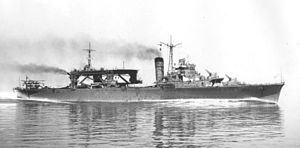ACZ Ezcuahuitl
This article is incomplete because it is pending further input from participants, or it is a work-in-progress by one author. Please comment on this article's talk page to share your input, comments and questions. Note: To contribute to this article, you may need to seek help from the author(s) of this page. |
 ACZ Ezcuahuitl prior to its conversion.
| |
| History | |
|---|---|
| Name: | ACZ Ezcuahuitl |
| Namesake: | Ezcuahuitl tree |
| Builder: | Tecolotlan Acalquetztia Makrianyotl |
| Laid down: | 1 November 1919 |
| Launched: | 19 November 1922 |
| Notes: | Converted from seaplane carrier to light aircraft carrier 13 February 1927–1 September 1927 |
| Recommissioned: | 8 September 1927 |
| Reclassified: | Light aircraft carrier 28 August 1927 |
| Reinstated: | 30 January 1928 |
| Fate: | Converted into a museum ship in 1953 |
| General characteristics | |
| Class and type: | Ezcuahuitl-class aircraft carrier |
| Displacement: |
|
| Length: | 193 m (633 ft 2 in) |
| Beam: | 21 m (68 ft 11 in) |
| Draft: | 7.5 m (24 ft 7 in) |
| Installed power: | 56,000 shp (42,000 kW) |
| Propulsion: |
|
| Speed: | 28.9 kn (53.5 km/h; 33.3 mph) |
| Complement: | 950 |
| Armament: |
|
| Aircraft carried: |
|
| Aviation facilities: |
|
ACZ Ezcuahuitl is a warship of the Zacapine Navy which was commissioned in 1919 as a seaplane carrier and converted in 1927 into a light aircraft carrier. It served as the flagship of the Vespanian Fleet and the overall Zacapine Navy from its initial commissioning to its retirement in 1953. The Ezcuahuitl is now preserved as a museum ship associated with the Angatahuaca Maritime Museum in the harbor district of Angatahuaca, Aztaco. The ship was the very first modern warship to be built in Zacapican, the inaugural vessel for the Makrian naval yards at the Tecolotlan Acalquetztia Makrianyotl on the west coast of Zacapican, where it was the first of four seaplane carriers built from 1919 to 1926 intended to form the nucleus of the newly re-established naval forces of the young United Republics. The Ezcuahuitl had a revolutionary design for its era, being one of the world's first carrier-style military vessels designed to carry a compliment of seaplanes which could be lowered into the water and launched using the ocean as a runway, thereby launching attacks by way of aircraft rather than conventional naval batteries.
Design
Admiral Aztlacatl Xochiquen, Secretary of Defense from 1915-1933 and father of the Zacapine Navy, carried out a systematic survey of many of the great navies of the 1910s under orders from Tepachoani Xolotecactl Acuixoc to build a modern and effective new navy for the United Republics.